Old City of Salamanca: Salamanca is famous for its university. The University of Salamanca is one of the oldest universities in Europe and the oldest university in Spain. The university was founded by King Alfonso IX in 1218. In 1224, it was one of the four great universities in the world along with the universities of Oxford, Paris and Bologna. The university has strongly influenced the history of Salamanca. Well known people have studied at the University of Salamanca such as Christopher Columbus and Miguel de Cervantes. The Art Nouveau and Art deco Museum houses collections of decorative art. La Plaza Mayor is the heart of the Old City of Salamanca. The Puente Mayor del Tormes is a Roman bridge crossing the Tormes River, the history of the bridge is connected to the city of Salamanca. The Roman bridge was an important part of the Ruta de la Plata, the Silver Route, an ancient road that runs from Mérida in the south to Astorga in the north. Salamanca is also known as La Dorade, the Golden City, because of the golden glow of its numerous sandstone buildings. The Old City of Salamanca is located about 200 km west of Madrid and about 80 km east of the border with Portugal. The Old City of Salamanca was declared a UNESCO World Heritage in 1988.
www.werelderfgoedfotos.nl © Copyright World Heritage Photos Classic Car Road Trip
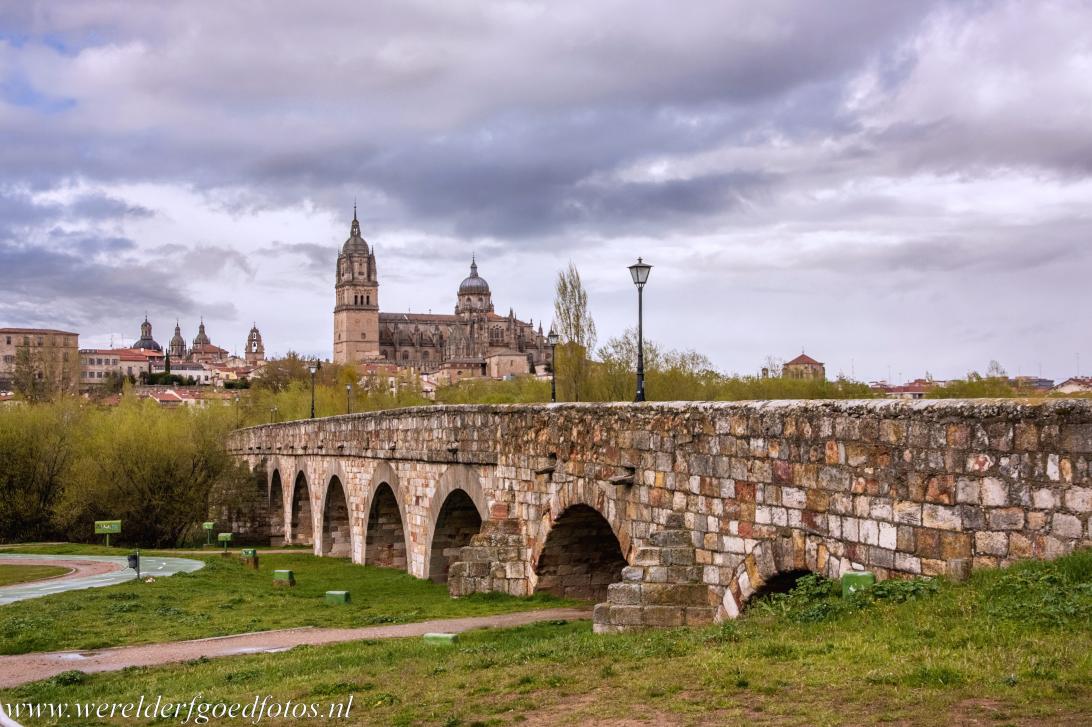
The Puente Mayor del Tormes, in the background the New Cathedral of the city of Salamanca. The Puente Mayor del Tormes is a Roman bridge crossing the Tormes River. The Roman bridge is a symbol of Salamanca, the bridge dates back to the first century AD. Salamanca is famous for its university, it has had a major influence on the history of the city. The University of Salamanca is the oldest university in Spain. The Old City of Salamanca is a UNESCO World Heritage.

The Puente Mayor del Tormes, in the background the New Cathedral of the city of Salamanca. The Puente Mayor del Tormes is a Roman bridge crossing the Tormes River. The Roman bridge is a symbol of Salamanca, the bridge dates back to the first century AD. Salamanca is famous for its university, it has had a major influence on the history of the city. The University of Salamanca is the oldest university in Spain. The Old City of Salamanca is a UNESCO World Heritage.
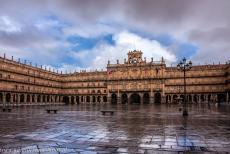
Old City of Salamanca: The City Hall on the Plaza Mayor, the main square in Salamanca, the City Hall was built in the Baroque style, the building has five granite arches and a typical Spanish bell tower. The Plaza Mayor was constructed between 1729 and 1775, the large square was used for bullfighting until the middle of the 19th century. Today, the Plaza Mayor is the most important urban space in the Old City of Salamanca. The Plaza Mayor is surrounded by Baroque arcades.
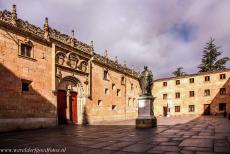
Old City of Salamanca: The Patio de las Escuelas, the square in front of the historic University of Salamanca. In the centre of the square stands a statue of the Augustinian friar, theologian and lyric poet Fray Luis de Leon, the most renowned professor of the University of Salamanca. The University of Salamanca has strongly influenced the history of Salamanca. Salamanca is known as La Dorade, the Golden City, because of the warm golden glow of the sandstone buildings.
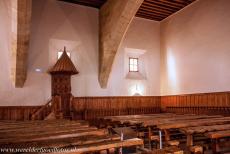
Old City of Salamanca: The lecture hall of Fray Luis de León in the University of Salamanca. In the middle of a lecture, professor Luis de León was arrested by the Inquisition and imprisoned for translating the Biblical Song of Songs into Spanish, which was forbidden at the time. In 1577, he returned to his lecture hall after five years as a prisoner of the Inquisition and he started his first lecture with the famous phrase 'Dicebamus hesterna die', As we were saying yesterday........
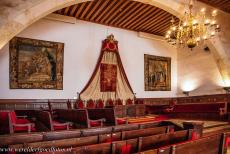
Old City of Salamanca: The Paraninfo or the Great Hall is the auditorium of the old University of Salamanca. The University is the oldest university of Spain. The university was founded by King Alfonso IX of León in 1218. In 1224, it was one of the four great universities in the world, along with the universities of Oxford, Paris and Bologna. Many well known people have studied at the University of Salamanca such as Miguel de Cervantes and Christopher Columbus.
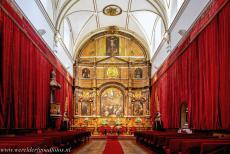
Old City of Salamanca: The chapel of the University of Salamanca was built between 1761 and 1767. The enormous altarpiece is embellished with several paintings and white and pink marble, inlaid with bronze ornaments. The walls are covered with red velvet curtains. In March 1856, the mortal remains of Fray Luis de León, the most famous professor of the University of Salamanca, were interred in the chapel, the tomb of Luis de León is situated on the right side of the chapel.
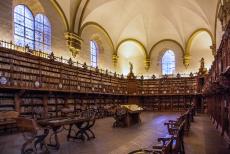
Old City of Salamanca: The Old Library of the historic University of Salamanca. The Old Library was established in 1254, only a few years after the foundation of the University of Salamanca. The Old Library was partially demolished in 1664 and rebuilt in 1749 into its current state. The library possesses 2,805 manuscripts, the oldest dating from the 11th century, including 480 incunabula. The library also houses 60,000 books printed between the 16th century and 1830.
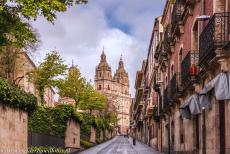
Old City of Salamanca: One of the historical alleys, in the background the Clerecia Church, also known as the Church of the Holy Spirit. The Baroque church was built around 1617. The towers are embellished with pinnacles and statues. The main altar was created in 1659. The Church of the Holy Spirit is situated next to the Casa de las Conchas, this former urban palace now houses a public library. Old City of Salamanca was added to the UNESCO World Heritage List in 1988.
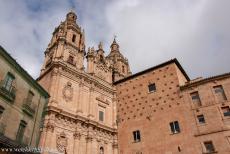
Old City of Salamanca: The Clerecia Church and the Casa de las Conchas, the House of Shells. The Casa de las Conchas was built in the period 1493-1517 for Rodrigo Maldonado de Talavera, a knight of the Order of Santiago, a religious and military order, he was also a professor at the University of Salamanca. The name of the Casa de las Conchas is due to the fact that the façade of the building is decorated with more than 300 sculpted scallop shells.
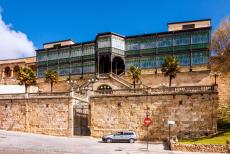
Old City of Salamanca: The Art Nouveau and Art Deco Museum is also known as the Casa Lis. The Art Nouveau and Art deco Museum houses collections of decorative art dating from the end of the 19th and the beginning of the 20th centuries. The museum houses about 2,500 art works, such as porcelain dolls, glass work, ivory and gold statues, furniture, jewels, toys, paintings and a Fabergé egg. The mansion was built for Miguel de Lis in 1905 and became a museum in 1981.
